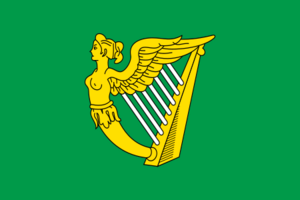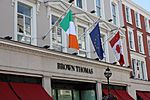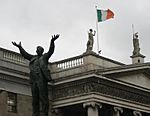Flag of Ireland facts for kids
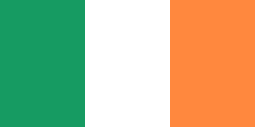 |
|
| Name | Bratach na hÉireann 'the Tricolour' |
|---|---|
| Use | National flag and ensign |
| Proportion | 1:2 |
| Adopted | 1922 (constitutional status; 1937) |
| Design | A vertical tricolour of green, white and orange |
The national flag of Ireland is often called 'the tricolour'. It has three vertical stripes: green, white, and orange. The flag is twice as wide as it is high.
This flag was first given as a gift in 1848 to Thomas Francis Meagher. It came from a group of French women who supported the Irish cause. The flag was meant to show peace and unity between Roman Catholics (green) and Protestants (orange). Meagher explained that the white stripe in the middle means "a lasting truce between Orange and Green." He hoped that Irish Protestants and Catholics could come together in friendship under this flag.
The tricolour became known as the national flag during the Easter Rising in 1916. It was raised over Dublin's General Post Office. Later, the Irish Republic used it during the Irish War of Independence (1919–1921). The flag continued to be used by the Irish Free State (1922–1937). In 1937, it officially became the national flag under the Constitution of Ireland. Today, many Irish nationalists use this flag as a symbol for the whole island of Ireland, including in Northern Ireland.
Contents
What the Flag Looks Like and Means
The Constitution of Ireland simply says that "The national flag is the tricolour of green, white and orange." The flag should be a rectangle. Its length should be two times its width. The three stripes—green, white, and orange—must be the same size and stand vertically.
When you display the flag, the green stripe should be closest to the flagpole. The white stripe is in the middle, and the orange stripe is at the end, farthest from the flagpole.
What Each Colour Symbolises
The green stripe stands for Irish republicanism. This idea goes back to the 1790s. The orange stripe represents the minority of people who supported King William III. He was from the House of Orange and defeated King James II in 1690 at the Battle of the Boyne. The orange colour was included to try and bring together the Orange Order (a Protestant group) with the Irish independence movement.
The white stripe in the middle means a lasting peace between these two groups. It shows a hope for people of different backgrounds to live together peacefully. The flag as a whole aims to symbolise the unity of all people on the island of Ireland. This means everyone born in Ireland can be part of the independent Irish nation, no matter their background or beliefs.
Sometimes, you might see a yellow stripe instead of orange. However, this is incorrect and should not be encouraged. The official colour is orange. In songs and poems, the colours are sometimes called "green, white and gold." This is poetic licence, meaning it's okay for art, but not for the actual flag.
History of the Irish Flag
A green flag with a harp was used by Owen Roe O'Neill in 1642. In the late 1700s, green became a colour linked to revolution. The United Irishmen, formed in the 1790s, were inspired by the French Revolution. They used a green flag with a harp.
After the Irish rebellion of 1798, there was a desire to bring together the "green" (republican) and "orange" (loyal to Britain) traditions. People hoped to create a self-governing Ireland based on peace between these groups.
The first known use of green, white, and orange together as a nationalist symbol was in 1830. People wore tricolour ribbons to celebrate the French Revolution. But the flag didn't become widely known until 1848. On March 7, 1848, Thomas Francis Meagher, a leader of the Young Irelanders, first showed the flag publicly in Waterford. He spoke to a crowd celebrating another revolution in France.
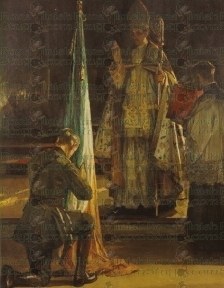
The flag was inspired by the tricolour flags of France and Newfoundland. Meagher's speeches at the time suggest it was a new idea, not an old flag being brought back. From March 1848, Irish tricolours appeared alongside French ones at meetings across the country.
Even though the tricolour was a symbol of unity and revolution, it wasn't used much between 1848 and 1916. Before the Easter Rising in 1916, the green flag with a harp was still the main symbol. The order of the colours in early tricolours was not always the same. Sometimes orange was near the flagpole.
After the Easter Rising in 1916, the tricolour became very popular. It was seen as the flag of the new revolutionary Ireland. Many Irish people began to see it as their national flag.
When the Irish Free State was formed in 1922, its government adopted the tricolour. The Free State's constitution didn't specifically name national symbols, but the flag was used. In 1937, the new Constitution of Ireland officially made the tricolour the national flag.
Use in Northern Ireland
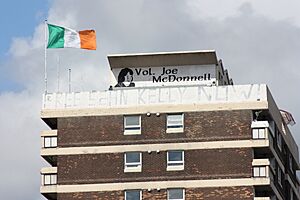
In 1921, Ireland was divided. The north-east became Northern Ireland, while the rest of Ireland formed the Irish Free State. Northern Ireland continued to use the British Union Flag. It also created its own flag, the Ulster Banner.
For many years, the tricolour was almost banned in Northern Ireland. A law from 1954 allowed police to remove any flag that might cause trouble. However, it said the Union Flag could never cause trouble. In 1964, police removed a tricolour from a Sinn Féin office in Belfast. This led to two days of riots. The flag was put back, showing how hard it was to enforce the law.

Even though the tricolour was meant to symbolise unity, in Northern Ireland it has become a symbol of division. Unionists and loyalists fly the Ulster Banner and the Union Flag. Nationalists and republicans fly the tricolour. Each community uses its own flags and symbols to show who they support. Sometimes, this can cause problems.
The Belfast Agreement (also called the Good Friday Agreement) in 1998 recognised that flags are still a source of disagreement in Northern Ireland. The agreement said that symbols should be used in a way that promotes respect, not division. Unionists believe the agreement means the Union Flag is the only official flag in Northern Ireland. Nationalists think the tricolour should be flown alongside the British flag on government buildings. However, the tricolour is never flown from official buildings there.
How to Show Respect for the Flag
The Irish government has given advice on how to treat the national flag with respect. These are guidelines, not strict laws. However, it is expected that everyone will treat the flag with proper respect.
Here are some important rules for displaying the flag:
- No other flag should be flown above the national flag.
- When carried with other flags, the national flag should be in the place of honour. This means on the marching right, or to the left of someone watching.
- If the European Union flag is also present, it should be immediately to the left of the national flag.
- When displayed against a wall, the green stripe should be on the right (from the observer's left) if horizontal. If vertical, the green should be at the top.
- The flag should not touch the ground or trail in water.
- When raising or lowering the flag, do not let it touch the ground.
- When raising to half-mast, first raise it to the very top, then lower it to half-mast. Before lowering it completely, raise it to the top again.
- During ceremonies, when the flag is raised, lowered, or passes in a parade, everyone should face it, stand still, and salute. People in uniform salute with their hand. Civilians stand to attention.
- When the national anthem is played, face the flag, stand still, and salute until the music ends.
The national flag should be replaced if it becomes worn or damaged. It should never be used in a way that shows disrespect. For example, do not put slogans or pictures on it. Do not drape it over cars or trains. It should always be carried high and free, unless it is used to cover a coffin. When covering a coffin, the green stripe should be at the head. The tricolour is used to cover the coffins of important people, like Presidents or soldiers killed in duty.
The national flag is flown every day at military bases and important government buildings. The European flag is often flown next to it. You will see the flag flying over places like the President's home, the Irish parliament (when it's meeting), courts, and police stations.
The flag is also flown on special days. These include Saint Patrick's Day, Easter Sunday and Easter Monday (to remember the 1916 Easter Rising), and the National Day of Commemoration. On these days, many private homes and businesses also fly the flag. The flag is often flown at half-mast when an important person dies.
Images for kids
See also
 In Spanish: Bandera de Irlanda para niños
In Spanish: Bandera de Irlanda para niños


